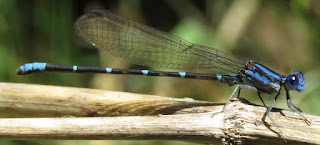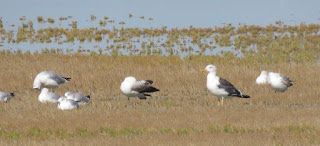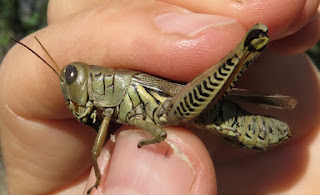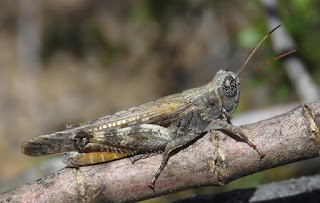With just
over two weeks at home in Tucson, I packed in quite a few activities before
heading for a three-week trip to Ecuador and Peru – dinner with friends, a
couple birding outings, working in the garden, and even a quick jaunt to Utah
to visit family.
One of the
local outings was to Finger Rock Canyon on the northern edge of Tucson for my
friend Kim’s twelve-year-old daughter Dawn, who is uncommonly keen about bugs
for a pre-teen girl. I enlisted the help of my friend Margarethe Brummermann,
who really knows her bugs, to help encourage Dawn’s interest by taking her out
on her first bugging walk. It was pretty dry and hot, there was not a ton of
activity, and like any girl her age she often got bored and impatient. But when
we found something, Dawn was energized. Here she is with a Mexican Bush
Katydid.
She had an
amazing eye for spotting little things, such as this tiny nymph of what
Margarethe suspected was a plant bug.
There were
plenty of fascinating bees and wasps finding nectar at blooming dodder and a buckwheat
plant, but Dawn was afraid of them – while dashing after to grab grasshoppers
and almost any other bug. She waited impatiently for me to take photos of these
grasshoppers, which she is still learning how to hold without letting them slip
away.
Rhammatocerus viatorius, Traveller
Grasshopper
Horesidotes cinereus, Ash-gray Range
Grasshopper
It was a
lovely area in any event. Here’s looking upcanyon towards the namesake and then
downcanyon over Tucson.
I also had a
great morning of birding, the first I’ve done in Arizona since the Pine
Flycatcher in early June, with my friends Keith and Patty along the Santa Cruz
River just south of Tumacacori. We found a Black-and-white Warbler, of which I
got a lousy photo.
With it was
a trio of vireos: Huttons’, Cassin’s, and this Plumbeous.
We saw many
other great birds (Gray Hawk, Painted and Varied Buntings), but as we walked
down the stream bed (in rubber boots), I got distracted by the diversity of
odonates – at least six species of damselflies and two dragonflies were present
at once, and I got photos of the following:
Argia nahuana, Aztec Dancer
Argia pallens, Amethyst Dancer
Argia sedula, Blue-ringed Dancer
Hetaerina americana, American Rubyspot
A lifer for
me was this Copaeodes minima,
Southern Skipperling, which used to be only very rare in the state but has
apparently staged an invasion the past couple of years near the border. From
reports I could find online, this might be the farthest north so far though.
My trip to Utah was spurred by the birth of my neice Cherice’s baby this past
February, whom I hadn’t met yet. This happy, amazingly adorable cherub, looking
like a China doll even in real life is Bentley Eolah Erkkila, my sister’s fifth grandchild.
It was good
to see the whole family, here my sister, her husband, and their five daughters. The other four grandkids were playing around the house.
I also
visited my brother and his family, and failed to get any photos there, except
for the morning I went out birding at Farmington Bay the day before the weather
was supposed to get bad. I found a Lesser Black-backed Gull there (the larger, darker gull with yellow legs; the others are California Gulls), which wasn’t
quite as rare as I had thought. Ten years ago it would have had all the state
listers there in a flash, but now they expect two or three each year.
I still have
to spend time looking up most grasshoppers I find, but this one I recognized
right away, Melanoplus differentialis,
Differential Grasshopper, based on those distinctive black herringbone marks on
the femur.
Speaking of
grasshoppers, while running errands at home, I often bike though a neighborhood
about 1/2 mile south of me we call the “dirt road neighborhood.” Parcels are
several acres, one-story houses are set well off the roads, and the habitat is
largely the original cactus and creosote bush desert scrub that once covered countless
square miles of the valley here. It’s now an extremely rare island in the urban
sprawl filled with introduced Mediterranean, South African, and Australian
plants. Every time I passed through here on my bicycle (remember, I don’t own a
car), I heard a distinctive clicking I didn’t recognize, and I finally stopped once and found a few of these small grasshoppers holding territories in individual creosote
bushes (Larrea divaricata var. tridentata). It didn’t take too much
time to find that they are Ligurotettix
coquilletti, the Desert Clicker Grasshopper.
They were easy
to approach and find, continuing to click at close quarters, unlike most
insects that stop at the first sign of danger. If you get too close, these
little orthopterans do hop and fly, but unlike most grasshoppers, they are
lightning fast and land with the precision of a fly on a tiny twig on the
opposite side of the bush. I had never seen anything like it in a grasshopper,
some of which bonk into trees or land in rivers in their typically random escape methods.
These then begin clicking again within a minute, certain of their ability to
evade the next predatory attempt. It took me several tries of catching one before I got one for
closer photos of the entire bug. I returned later with my camera, tripod, and
sound recording equipment (a Sennheiser ME67 microphone and Olympus LS14
digital recorder), and made this video. The camera does record sound with the
video, but it’s not very good, so I learned to use iMovie to replace the
camera’s video sound with the file I made with my superior recording equipment.
I was rather pleased with the outcome.
To complete
the blog, here’s a single photo of the halfway point of the rejuvenation of my
winter vegetable garden. It’s only 91 square feet (10 x 10 minus a 3 x 3 square
to accommodate the agave), but it took most of four days to do a “double dig”
that felt more like a “triple dig.” It basically involved removing all the
mesquite rootlets that rob the water before anything else can get it by digging
at least two feet down. I then incorporated five large
bags of peat moss to add badly needed organic material, added four more lines
of drip hose, replanted the few plants that had been struggling along (a
tomato, three peppers, a Thai basil), and then sowed seeds of 27 kinds of
winter veggies. Timer set to water it for 45 minutes each day, then off to
Ecuador and Peru.
























No comments:
Post a Comment